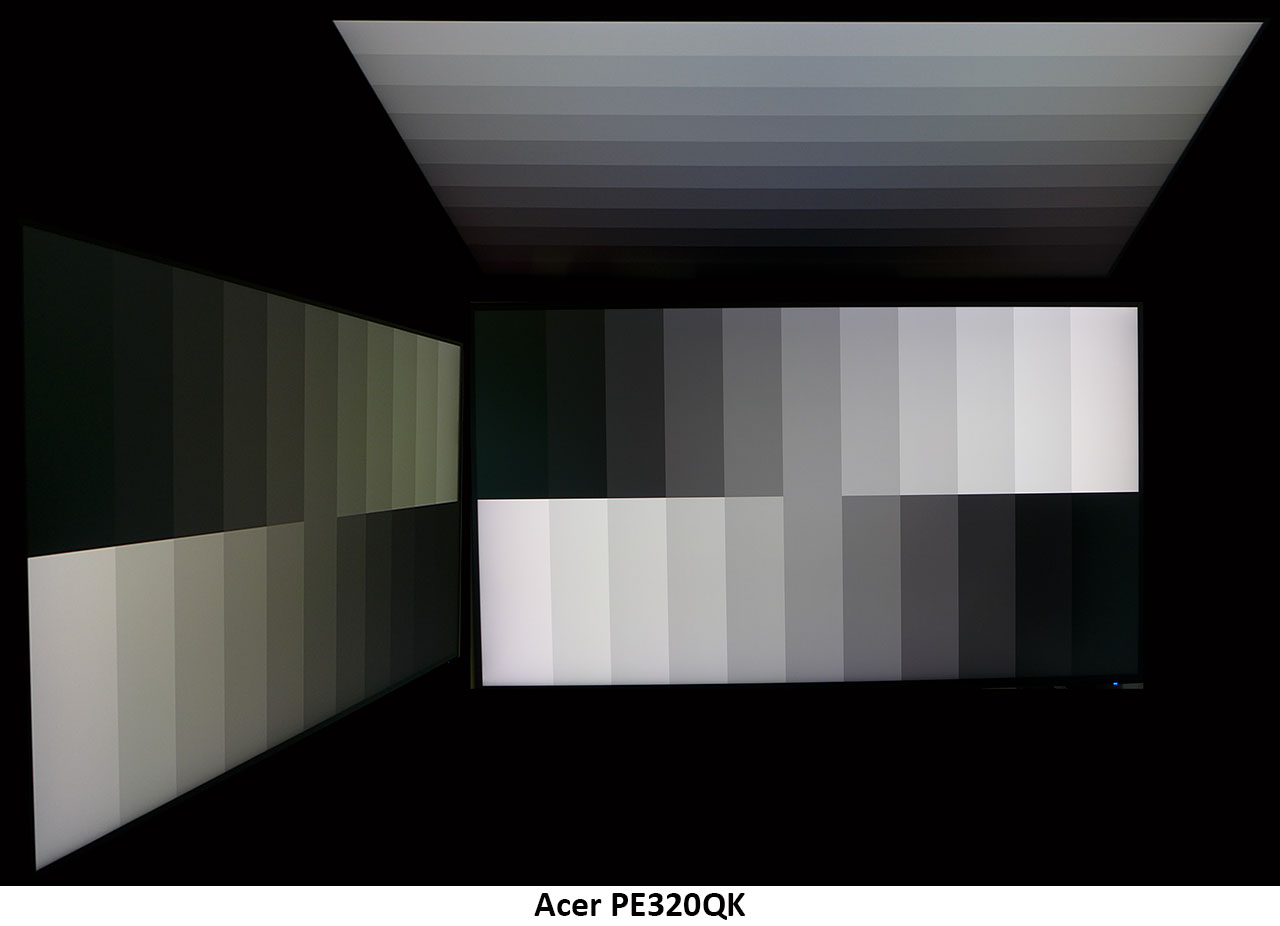Acer PE320QK 32" Ultra HD HDR Monitor Review: A Strong FreeSync Value
Why you can trust Tom's Hardware
Viewing Angles, Uniformity, Response & Lag
Viewing Angles
The PE320QK offers typical off-axis performance that competes favorably with other IPS panels. The side view is decidedly green, with a 40% brightness reduction, while the top view goes a bit blue and loses some detail. All the steps are visible, though, which is a good thing. At normal viewing distances and angles, the monitor looks superb.
Screen Uniformity
To learn how we measure screen uniformity, please click here.
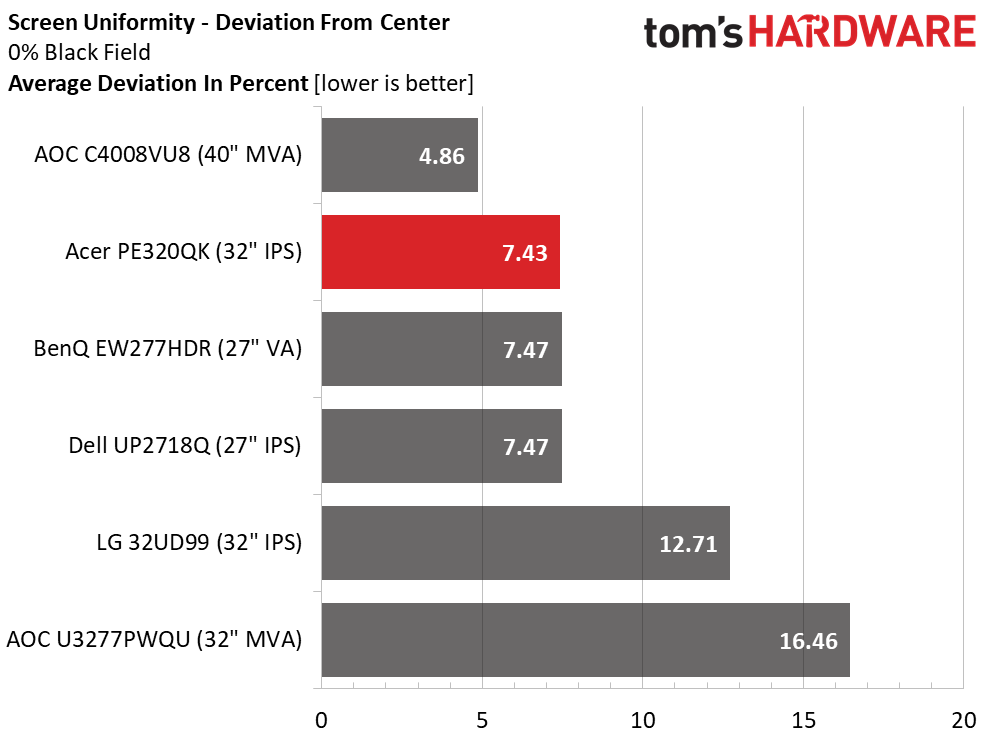
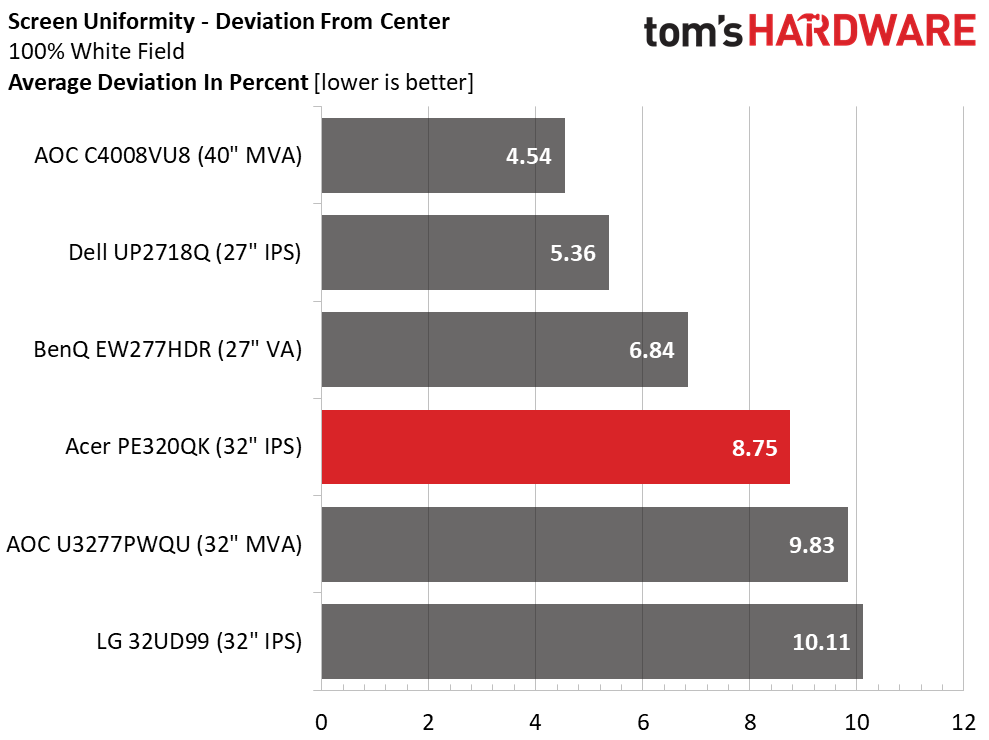
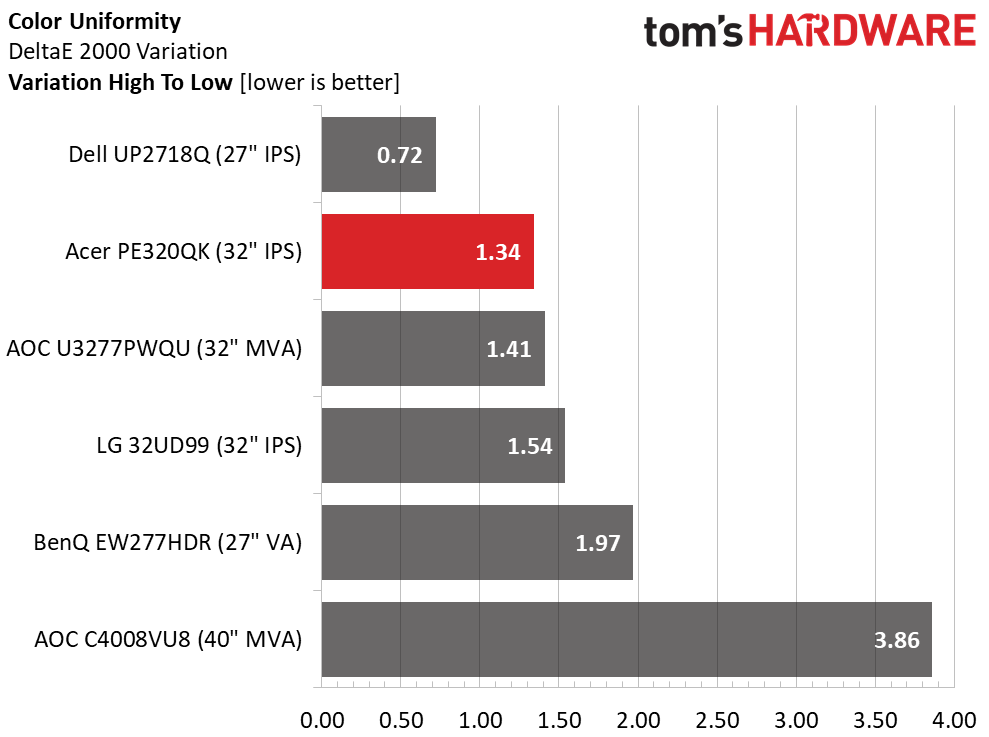
The PE320QK is one of the few professional displays not to offer uniformity compensation. We’re glad that Acer has not wasted its time. We’ve measured the effects of that feature on dozens of monitors and in every case, found it to reduce contrast far more than it improved uniformity. Our Acer sample looks visually perfect with no hotspots, bleed, or glow. The 80% field pattern has no color shifts, either, just a smooth tone from edge to edge.
Pixel Response & Input Lag
Please click here to read up on our pixel response and input lag testing procedures.
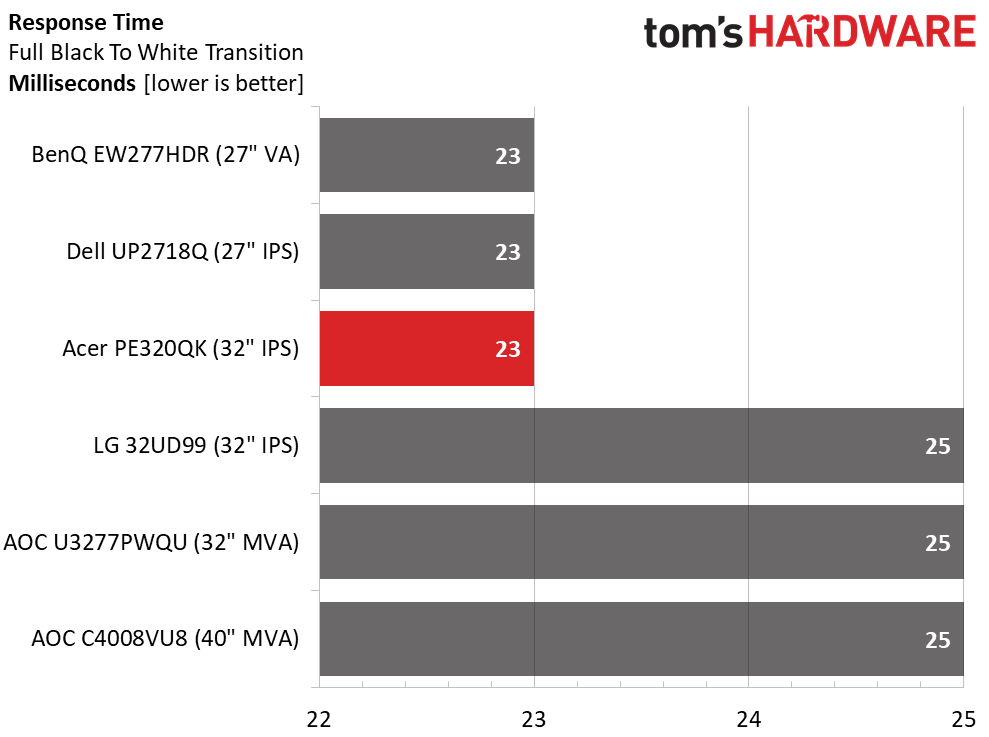
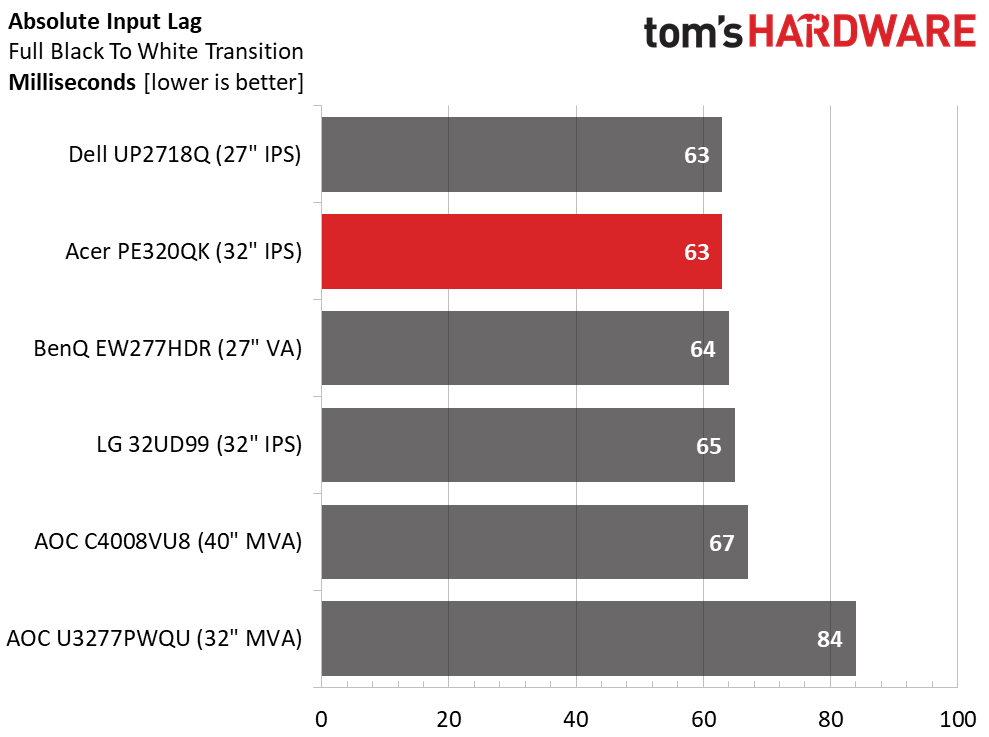
Despite Acer’s excellent FreeSync implementation in the PE320QK, it is not up to the speed standards set by today’s gaming displays. When hampered by a 60Hz refresh rate, motion quality reaches a limit that only more hertz can overcome. Response and lag are on the faster side of this group, however. Those who value pixel density over framerates will be very happy with this monitor.
Gaming With FreeSync
In a professional monitor, one might speculate that FreeSync is simply added as an afterthought; a feature designed to attract buyers rather than add true value. Happily, that is not the case with the PE320QK. It stays in FreeSync mode all the way down to 24Hz, which means LFC is in play. It’s one of the only Ultra HD monitors we’ve seen that does this.
How much does that 60Hz limit matter? In our case, it doesn’t because we’re still testing FreeSync with a Radeon R9 285 card. It can manage 50-60 FPS if we turn the detail down to mid-levels. And here’s a surprise: When we upped the detail in Tomb Raider to Ultra, framerates dropped to between 25 and 35 FPS, and the game was still playable.
Get Tom's Hardware's best news and in-depth reviews, straight to your inbox.
Clearly, LFC really makes a difference when speeds are low. It doesn’t seem to be a factor in monitors with lower resolution, but we’d say don’t buy an Ultra HD display without it if gaming performance is a priority. The only negative we observed is that overdrive is locked to Normal in FreeSync mode. However, motion quality does not seem to be affected. Our response test shows a reasonably fast panel, and blur just wasn’t an issue during gameplay. The PE320QK is a better gaming screen than one might think, and it certainly exceeds our expectations for a professional monitor.
MORE: Best Gaming Monitors
MORE: Best Professional Monitors
MORE: How We Test Monitors
MORE: How To Choose A Monitor
MORE: All Monitor Content
Current page: Viewing Angles, Uniformity, Response & Lag
Prev Page HDR Tests & Hands-on Next Page Conclusion
Christian Eberle is a Contributing Editor for Tom's Hardware US. He's a veteran reviewer of A/V equipment, specializing in monitors. Christian began his obsession with tech when he built his first PC in 1991, a 286 running DOS 3.0 at a blazing 12MHz. In 2006, he undertook training from the Imaging Science Foundation in video calibration and testing and thus started a passion for precise imaging that persists to this day. He is also a professional musician with a degree from the New England Conservatory as a classical bassoonist which he used to good effect as a performer with the West Point Army Band from 1987 to 2013. He enjoys watching movies and listening to high-end audio in his custom-built home theater and can be seen riding trails near his home on a race-ready ICE VTX recumbent trike. Christian enjoys the endless summer in Florida where he lives with his wife and Chihuahua and plays with orchestras around the state.
-
Ninjawithagun Only 60Hz? No G-Sync? No Dolby Vision (only HDR 10 Plus)? No 12-bit color? Pass.Reply -
cryoburner Reply20849446 said:Only 60Hz? No G-Sync? No Dolby Vision (only HDR 10 Plus)? No 12-bit color? Pass.
It's a 4K monitor. The last I checked, high-refresh rate 4K screens aren't really a thing yet, and if we're talking about gaming (which this screen isn't really targeted toward) even a 1080 Ti will struggle to get 60 fps at max settings in many games. As for Dolby Vision and G-Sync, they are proprietary technologies that would drive up the cost of the display and be of limited use to the professional market that it's targeted toward, and the screen does support the open standard equivalent technologies to both. -
JonDol Reply20850771 said:20849446 said:Only 60Hz? No G-Sync? No Dolby Vision (only HDR 10 Plus)? No 12-bit color? Pass.
It's a 4K monitor. The last I checked, high-refresh rate 4K screens aren't really a thing yet, and if we're talking about gaming (which this screen isn't really targeted toward) even a 1080 Ti will struggle to get 60 fps at max settings in many games. As for Dolby Vision and G-Sync, they are proprietary technologies that would drive up the cost of the display and be of limited use to the professional market that it's targeted toward, and the screen does support the open standard equivalent technologies to both.
There are lots of peoples who don't care about the extra cost of those proprietary technologies but just want that such a monitor exists and that, sadly, isn't the case yet. And they care even less if a today 1080 Ti will agonize displaying those games because such a monitor is a future proof investment. Just as a reminder, the same was the case over a decade ago when the first FHD monitors came to market: the best video cards were also struggling with the max settings at that resolution...
Cheers
-
sephirotic Reply20852386 said:20850771 said:20849446 said:Only 60Hz? No G-Sync? No Dolby Vision (only HDR 10 Plus)? No 12-bit color? Pass.
It's a 4K monitor. The last I checked, high-refresh rate 4K screens aren't really a thing yet, and if we're talking about gaming (which this screen isn't really targeted toward) even a 1080 Ti will struggle to get 60 fps at max settings in many games. As for Dolby Vision and G-Sync, they are proprietary technologies that would drive up the cost of the display and be of limited use to the professional market that it's targeted toward, and the screen does support the open standard equivalent technologies to both.
There are lots of peoples who don't care about the extra cost of those proprietary technologies but just want that such a monitor exists and that, sadly, isn't the case yet. And they care even less if a today 1080 Ti will agonize displaying those games because such a monitor is a future proof investment. Just as a reminder, the same was the case over a decade ago when the first FHD monitors came to market: the best video cards were also struggling with the max settings at that resolution...
Cheers
144hz is dumb gaming gimmick.
However 60hz in this day and age is unnaceptable even for professional use. I'm tired of editing 24fps content with judderr or at lower 48hz. 75/72hz should have been the new standard for a long time now. Modern ips is perfect capable of refreshing at 12ms, even half of that full g2g without overdrive.
Monitor makers are completing neglecting their profissional and prosumer customers.
-
drajitsh I print using a photo printer. That means adobeRGB is still very very important. Also, 8 bit native means it is a enthusiast rather than pro monitor.Reply
